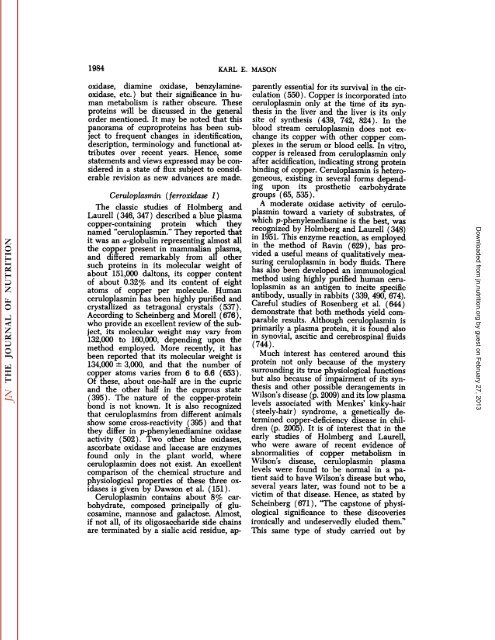conspectus of researchon copper metabolism and requirements
conspectus of researchon copper metabolism and requirements
conspectus of researchon copper metabolism and requirements
Create successful ePaper yourself
Turn your PDF publications into a flip-book with our unique Google optimized e-Paper software.
1984 KARL E. MASON<br />
oxidase, diamine oxidase, benzylamineoxidase,<br />
etc.) but their significance in hu<br />
man <strong>metabolism</strong> is rather obscure. These<br />
proteins will be discussed in the general<br />
order mentioned. It may be noted that this<br />
panorama <strong>of</strong> cuproproteins has been sub<br />
ject to frequent changes in identification,<br />
description, terminology <strong>and</strong> functional at<br />
tributes over recent years. Hence, some<br />
statements <strong>and</strong> views expressed may be con<br />
sidered in a state <strong>of</strong> flux subject to consid<br />
erable revision as new advances are made.<br />
Ceruloplasmin (ferroxidase I)<br />
The classic studies <strong>of</strong> Holmberg <strong>and</strong><br />
Laurell (346, 347 ) described a blue plasma<br />
<strong>copper</strong>-containing protein which they<br />
named "ceruloplasmin." They reported that<br />
it was an «-globulinrepresenting almost all<br />
the <strong>copper</strong> present in mammalian plasma,<br />
<strong>and</strong> differed remarkably from all other<br />
such proteins in its molecular weight <strong>of</strong><br />
about 151,000 daltons, its <strong>copper</strong> content<br />
<strong>of</strong> about 0.32% <strong>and</strong> its content <strong>of</strong> eight<br />
atoms <strong>of</strong> <strong>copper</strong> per molecule. Human<br />
ceruloplasmin has been highly purified <strong>and</strong><br />
crystallized as tetragonal crystals (537).<br />
According to Scheinberg <strong>and</strong> Morell (676),<br />
who provide an excellent review <strong>of</strong> the sub<br />
ject, its molecular weight may vary from<br />
132,000 to 160,000, depending upon the<br />
method employed. More recently, it has<br />
been reported that its molecular weight is<br />
134,000 ±3,000, <strong>and</strong> that the number <strong>of</strong><br />
<strong>copper</strong> atoms varies from 6 to 6.6 (653).<br />
Of these, about one-half are in the cupric<br />
<strong>and</strong> the other half in the cuprous state<br />
(395). The nature <strong>of</strong> the <strong>copper</strong>-protein<br />
bond is not known. It is also recognized<br />
that ceruloplasmins from different animals<br />
show some cross-reactivity (395) <strong>and</strong> that<br />
they differ in p-phenylenediamine oxidase<br />
activity (502). Two other blue oxidases,<br />
ascorbate oxidase <strong>and</strong> lacease are enzymes<br />
found only in the plant world, where<br />
ceruloplasmin does not exist. An excellent<br />
comparison <strong>of</strong> the chemical structure <strong>and</strong><br />
physiological properties <strong>of</strong> these three ox<br />
idases is given by Dawson et al. (151).<br />
Ceruloplasmin contains about 8% car<br />
bohydrate, composed principally <strong>of</strong> glucosamine,<br />
mannose <strong>and</strong> galactose. Almost,<br />
if not all, <strong>of</strong> its oligosaccharide side chains<br />
are terminated by a sialic acid residue, ap<br />
parently essential for its survival in the cir<br />
culation (550). Copper is incorporated into<br />
ceruloplasmin only at the time <strong>of</strong> its syn<br />
thesis in the liver <strong>and</strong> the liver is its only<br />
site <strong>of</strong> synthesis (439, 742, 824). In the<br />
blood stream ceruloplasmin does not ex<br />
change its <strong>copper</strong> with other <strong>copper</strong> com<br />
plexes in the serum or blood cells. In vitro,<br />
<strong>copper</strong> is released from ceruloplasmin only<br />
after acidification, indicating strong protein<br />
binding <strong>of</strong> <strong>copper</strong>. Ceruloplasmin is hetero<br />
geneous, existing in several forms depend<br />
ing upon its prosthetic carbohydrate<br />
groups (65, 535).<br />
A moderate oxidase activity <strong>of</strong> cerulo<br />
plasmin toward a variety <strong>of</strong> substrates, <strong>of</strong><br />
which p-phenylenediamine is the best, was<br />
recognized by Holmberg <strong>and</strong> Laurell (348)<br />
in 1951. This enzyme reaction, as employed<br />
in the method <strong>of</strong> Ravin (629), has pro<br />
vided a useful means <strong>of</strong> qualitatively mea<br />
suring ceruloplasmin in body fluids. There<br />
has also been developed an immunological<br />
method using highly purified human ceru<br />
loplasmin as an antigen to incite specific<br />
antibody, usually in rabbits (339, 490, 674).<br />
Careful studies <strong>of</strong> Rosenberg et al. (644)<br />
demonstrate that both methods yield com<br />
parable results. Although ceruloplasmin is<br />
primarily a plasma protein, it is found also<br />
in synovial, ascitic <strong>and</strong> cerebrospinal fluids<br />
(744).<br />
Much interest has centered around this<br />
protein not only because <strong>of</strong> the mystery<br />
surrounding its true physiological functions<br />
but also because <strong>of</strong> impairment <strong>of</strong> its syn<br />
thesis <strong>and</strong> other possible derangements in<br />
Wilson's disease (p. 2009) <strong>and</strong> its low plasma<br />
levels associated with Menkes' kinky-hair<br />
(steely-hair) syndrome, a genetically de<br />
termined <strong>copper</strong>-deficiency disease in chil<br />
dren (p. 2005). It is <strong>of</strong> interest that in the<br />
early studies <strong>of</strong> Holmberg <strong>and</strong> Laurell,<br />
who were aware <strong>of</strong> recent evidence <strong>of</strong><br />
abnormalities <strong>of</strong> <strong>copper</strong> <strong>metabolism</strong> in<br />
Wilson's disease, ceruloplasmin plasma<br />
levels were found to be normal in a pa<br />
tient said to have Wilson's disease but who,<br />
several years later, was found not to be a<br />
victim <strong>of</strong> that disease. Hence, as stated by<br />
Scheinberg (671 ), "The capstone <strong>of</strong> physi<br />
ological significance to these discoveries<br />
ironically <strong>and</strong> undeservedly eluded them/'<br />
This same type <strong>of</strong> study carried out by<br />
Downloaded from<br />
jn.nutrition.org<br />
by guest on February 27, 2013
















